Efficacy and Satisfaction of Low Doses UVA1 Phototherapy: A Spanish Experience from a Single Centre
Abstract
1. Introduction
2. Materials and Methods
3. Results
4. Discussion
5. Conclusions
Author Contributions
Funding
Institutional Review Board Statement
Informed Consent Statement
Data Availability Statement
Conflicts of Interest
References
- Prasad, S.A.; Coias, J.; Chen, H.W.; Jacobe, H. Utilizing UVA-1 Phototherapy. Dermatol. Clin. 2020, 38, 79–90. [Google Scholar] [CrossRef] [PubMed]
- Pitney, T.; Pitney, M.J. A retrospective review of UVA1 treatment: An Australian experience from a single centre. Australas. J. Dermatol. 2020, 61, 318–323. [Google Scholar] [CrossRef] [PubMed]
- Tuchinda, C.; Kerr, H.A.; Taylor, C.R.; Jacobe, H.; Bergamo, B.M.; Elmets, C.; Rivard, J.; Lim, H.W. UVA1 phototherapy for cutaneous diseases: An experience of 92 cases in the United States. Photodermatol. Photoimmunol. Photomed. 2006, 22, 247–253. [Google Scholar] [CrossRef] [PubMed]
- Gambichler, T.; Terras, S.; Kreuter, A. Treatment regimens, protocols, dosage, and indications for UVA1 phototherapy: Facts and controversies. Clin. Dermatol. 2013, 31, 438–454. [Google Scholar] [CrossRef] [PubMed]
- Yamauchi, R.; Morita, A.; Yasuda, Y.; Grether-Beck, S.; Klotz, L.-O.; Tsuji, T.; Krutmann, J. Different Susceptibility of Malignant versus Nonmalignant Human T Cells toward Ultraviolet A-1 Radiation-Induced Apoptosis. J. Investig. Dermatol. 2004, 122, 477–483. [Google Scholar] [CrossRef] [PubMed]
- Gambichler, T.; Skrygan, M.; Tomi, N.S.; Breuksch, S.; Altmeyer, P.; Kreuter, A. Significant downregulation of transforming growth factor-beta signal transducers in human skin following ultraviolet-A1 irradiation. Br. J. Dermatol. 2007, 156, 951. [Google Scholar] [CrossRef]
- Kroft, E.B.; Berkhof, N.J.; van de Kerkhof, P.C.; Gerritsen, R.M.; de Jong, E.M. Ultraviolet A phototherapy for sclerotic skin diseases: A systematic review. J. Am. Acad. Dermatol. 2008, 59, 1017–1030. [Google Scholar] [CrossRef]
- Tognetti, L.; Marrocco, C.; Carraro, A.; Guerrini, G.; Mariotti, G.; Cinotti, E.; Rubegni, P. Clinical and laboratory characterization of patients with localized scleroderma and response to UVA -1 phototherapy: In vivo and in vitro skin models. Photodermatol. Photoimmunol. Photomed. 2022, 38, 531–540. [Google Scholar] [CrossRef]
- Gambichler, T.; Schmitz, L. Ultraviolet A1 Phototherapy for Fibrosing Conditions. Front. Med. 2018, 5, 237. [Google Scholar] [CrossRef]
- Connolly, K.; Griffith, J.L.; McEvoy, M.T.; Lim, H.W. Ultraviolet A1 phototherapy beyond morphea: Experience in 83 patients. Photodermatol. Photoimmunol. Photomed. 2015, 31, 289–295. [Google Scholar] [CrossRef]
- Stege, H.; Berneburg, M.; Humke, S.; Klammer, M.; Grewe, M.; Grether-Beck, S.; Boedeker, R.; Diepgen, T.; Dierks, K.; Goerz, G.; et al. High-dose UVA1 radiation therapy for localized scleroderma. J. Am. Acad. Dermatol. 1997, 36, 938–944. [Google Scholar] [CrossRef]
- Furuhashi, T.; Torii, K.; Ikumi, K.; Kato, H.; Nishida, E.; Morita, A. Ultraviolet A1 phototherapy for the treatment of localized scleroderma. J. Dermatol. 2020, 47, 792–795. [Google Scholar] [CrossRef]
- Zhu, J.L.; Black, S.M.; Chen, H.W.; Jacobe, H.T. Emerging treatments for scleroderma/systemic sclerosis. Fac. Rev. 2021, 10, 43. [Google Scholar] [CrossRef]
- El-Mofty, M.; Mostafa, W.; El-Darouty, M.; Bosseila, M.; Nada, H.; Yousef, R.; Esmat, S.; El-Lawindy, M.; Assaf, M.; El-Enani, G. Different low doses of broad-band UVA in the treatment of morphea and systemic sclerosis. A clinico-pathologic study. Photodermatol. Photoimmunol. Photomed. 2004, 20, 148–156. [Google Scholar] [CrossRef]
- Durand, F.; Staumont, D.; Bonnevalle, A.; Hachulla, E.; Hatron, P.-Y.; Thomas, P. Ultraviolet A1 phototherapy for treatment of acrosclerosis in systemic sclerosis: Controlled study with half-side comparison analysis. Photodermatol. Photoimmunol. Photomed. 2007, 23, 215–221. [Google Scholar] [CrossRef]
- Kreuter, A.; Breuckmann, F.; Uhle, A.; Brockmeyer, N.; von Kobyletzki, G.; Freitag, M.; Stuecker, M.; Hoffmann, K.; Gambichler, T.; Altmeyer, P. Low-dose UVA1 phototherapy in systemic sclerosis: Effects on acrosclerosis. J. Am. Acad. Dermatol. 2004, 50, 740–747. [Google Scholar] [CrossRef]
- Rose, R.F.; Turner, D.; Goodfield, M.J.D.; Goulden, V. Low-dose UVA1 pho- totherapy for proximal and acral scleroderma in systemic sclerosis. Photodermatol. Photoimmunol. Photomed. 2009, 25, 153–155. [Google Scholar] [CrossRef]
- Kreuter, A.; Gambichler, T.; Avermaete, A.; Happe, M.; Bacharach-Buhles, M.; Hoffmann, K.; Jansen, T.; Altmeyer, P.; von Kobyletzki, G. Low-dose ultraviolet A1 phototherapy for extragenital lichen sclerosus: Results of a preliminary study. J. Am. Acad. Dermatol. 2002, 46, 251–255. [Google Scholar] [CrossRef]
- Linares-González, L.; Ródenas-Herranz, T.; Espelt-Otero, J.; Ruiz-Villaverde, R. Escleredema de Buschke refractario a terapia convencional. Respuesta a UVA1. Actas Dermosifiliogr. 2021, 112, 466–468. [Google Scholar] [CrossRef]
- Janiga, J.J.; Ward, D.H.; Lim, H.W. UVA-1 as a treatment for scleredema. Photodermatol. Photoimmunol. Photomed. 2004, 20, 210–211. [Google Scholar] [CrossRef]
- Kochs, C.; Bockmann, A.; Hanneken, S.; Neumann, N.J. Scleredema diabeticorum: Successful treatment with UVA-1 phototherapy. Hautarzt 2011, 62, 255–257. [Google Scholar] [CrossRef] [PubMed]
- Thumpimukvatana, N.; Wongpraparut, C.; Lim, H.W. Scleredema diabeticorum successfully treated with ultraviolet A1 phototherapy. J. Dermatol. 2010, 37, 1036–1039. [Google Scholar] [CrossRef] [PubMed]
- Kroft, E.B.M.; de Jong, E.M.G.J. Scleredema Diabeticorum Case Series: Successful Treatment With UV-A1. Arch. Dermatol. 2008, 144, 947–948. [Google Scholar] [CrossRef] [PubMed]
- Hannuksela-Svahn, A.; Grandal, O.J.; Thorstensen, T.; Christensen, O.B. UVA1 for treatment of keloids. Acta Derm. Venereol. 1999, 79, 490. [Google Scholar] [CrossRef]
- Cuenca-Barrales, C.; Aneiros-Fernández, J.; Pérez-López, I.; Rodríguez-Pérez, J.; Ruiz-Villaverde, R.; Espelt-Otero, J.L. Histological Changes Related to Symptomatic Improvement of Spontaneous Keloids Treated with a Low-Dosage Regimen of UVA-1 Phototherapy. Dermatopathology 2020, 7, 53–56. [Google Scholar] [CrossRef]
- Sidbury, R.; Davis, D.M.; Cohen, D.E.; Cordoro, K.M.; Berger, T.G.; Bergman, J.N.; Chamlin, S.L.; Cohen, D.E.; Cooper, K.D. Guidelines of care for the management of atopic dermatitis: Section Management and treatment with phototherapy and systemic agents. J. Am. Acad. Dermatol. 2014, 71, 327–349. [Google Scholar] [CrossRef]
- Ordóñez Rubiano, M.F.; Arenas, C.M.; Chalela, J.G. UVA-1 phototherapy for the management of atopic dermatitis: A large retrospective study conducted in a low-middle income country. Int. J. Dermatol. 2018, 57, 799–803. [Google Scholar] [CrossRef]
- Musters, A.H.; Mashayekhi, S.; Flohr, C.; Drucker, A.M.; Gerbens, L.; Ferguson, J.; Ibbotson, S.; Dawe, R.S. Phototherapy for atopic eczema. Cochrane Libr. 2021, 10, CD013870. [Google Scholar]
- Pérez-Ferriols, A.; Aranegui, B.; Pujol-Montcusí, J.; Martín-Gorgojo, A.; Campos-Domínguez, M.; Feltes, R.; Gilaberte, Y.; Echeverría-García, B.; Alvarez-Pérez, A.; García-Doval, I. Phototherapy in Atopic Dermatitis: A Systematic Review of the Literature. Actas Dermosifiliogr. 2015, 106, 387–401. [Google Scholar] [CrossRef]
- Meduri, N.B.; Vandergriff, T.; Rasmussen, H.; Jacobe, H. Phototherapy in the management of atopic dermatitis: A systematic review. Photodermatol. Photoimmunol. Photomed. 2007, 23, 106–112. [Google Scholar] [CrossRef]
- Malinowska, K.; Woźniacka, A.; Bogaczewicz, J. The impact of medium dose UVA1 phototherapy on pruritus, DLQI and SCORAD index in patients with atopic dermatitis. Adv. Dermatol. Allergol. 2020, 37, 962–967. [Google Scholar] [CrossRef]
- Olsen, E.A.; Hodak, E.; Anderson, T.; Carter, J.B.; Henderson, M.; Cooper, K.; Lim, H.W. Guidelines for phototherapy of mycosis fungoides and Sézary syndrome: A consensus statement of the United States Cutaneous Lymphoma Consortium. J. Am. Acad. Dermatol. 2016, 74, 27–58. [Google Scholar] [CrossRef]
- Adışen, E.; Tektaş, V.; Erduran, F.; Erdem, Ö.; Gürer, M.A. Ultraviolet A1 Phototherapy in the Treatment of Early Mycosis Fungoides. Dermatology 2017, 233, 192–198. [Google Scholar] [CrossRef]
- Jang, M.S.; Kang, D.Y.; Jeon, Y.S.; Kim, S.T.; Suh, K.S. Ultraviolet A1 Phototherapy of Mycosis Fungoides. Ann. Dermatol. 2013, 25, 104–107. [Google Scholar] [CrossRef]
- Joshi, T.P.; Duvic, M. Granuloma Annulare: An Updated Review of Epidemiology, Pathogenesis, and Treatment Options. Am. J. Clin. Dermatol. 2021, 23, 37–50. [Google Scholar] [CrossRef]
- Nordmann, T.M.; Kim, J.-R.; Dummer, R.; Anzengruber, F. A Monocentric, Retrospective Analysis of 61 Patients with Generalized Granuloma Annulare. Dermatology 2020, 236, 369–374. [Google Scholar] [CrossRef]
- Aichelburg, M.; Pinkowicz, A.; Schuster, C.; Volc-Platzer, B.; Tanew, A. Patch granuloma annulare: Clinicopathological characteristics and response to phototherapy. Br. J. Dermatol. 2019, 181, 198–199. [Google Scholar] [CrossRef]
- Mukovozov, I.M.; Kashetsky, N.; Richer, V. Light- and laser-based treatments for granuloma annulare: A systematic review. Photodermatol. Photoimmunol. Photomed. 2022, 38, 301–310. [Google Scholar] [CrossRef]
- Gobello, T.; Mazzanti, C.; Sordi, D.; Annessi, G.; Abeni, D.; Chinni, L.M.; Girolomoni, G. Medium- versus high-dose ultraviolet A1 therapy for urticaria pigmentosa: A pilot study. J. Am. Acad. Dermatol. 2003, 49, 679–684. [Google Scholar] [CrossRef]
- Stege, H.; Schöpf, E.; Ruzicka, T.; Krutmann, J. High-dose UVA1 for urticaria pigmentosa. Lancet 1996, 347, 64. [Google Scholar] [CrossRef]
- Von Kobyletzki, G.; Kreuter, J.A.; Nordmeier, R.; Stücker, M.; Altmeyer, P. Treatment of idiopathic mucinosis follicularis with UVA1 cold light phototherapy. Dermatology 2000, 201, 76–77. [Google Scholar] [CrossRef] [PubMed]
- Arrieta, A.; Jaka, A.; del Alcázar, E.; Blanco, M.; Carrascosa, J.M. Fototerapia en el prurigo nodular. Experiencia propia y revisión de la literatura. Actas Dermosifiliogr. 2021, 112, 339–344. [Google Scholar] [CrossRef] [PubMed]
- Rombold, S.; Lobisch, K.; Katzer, K.; Grazziotin, T.C.; Ring, J.; Eberlein, B. Efficacy of UVA1 phototherapy in 230 patients with various skin diseases. Photodermatol. Photoimmunol. Photomed. 2008, 24, 19–23. [Google Scholar] [CrossRef] [PubMed]
- Bruni, E.; Caccialanza, M.; Piccinno, R. Phototherapy of generalized prurigo nodularis. Clin. Exp. Dermatol. 2009, 35, 549–550. [Google Scholar] [CrossRef]
- Schmidtt, A. UVA1 irradiation is effective in treatment of chronic vesicular dyshidrotic hand eczema. Acta Derm Venereol. 1998, 78, 318–319. [Google Scholar]
- Polderman, M.C.A.; Govaert, J.C.M.; le Cessie, S.; Pavel, S. A double-blind placebo-controlled trial of UVA-1 in the treatment of dyshidrotic eczema: UVA-1 for dyshidrotic eczema. Clin. Exp. Dermatol. 2003, 28, 584–587. [Google Scholar] [CrossRef]
- Petering, H.; Breuer, C.; Herbst, R.; Kapp, A.; Werfel, T. Comparison of localized high-dose UVA1 irradiation versus topical cream psoralen-UVA for treatment of chronic vesicular dyshidrotic eczema. J. Am. Acad. Dermatol. 2004, 50, 68–72. [Google Scholar] [CrossRef]
- Raap, U.; Kenneweg, C.; Kapp, A.; Werfel, T. Neue und seltener angewandte Therapieoptionen bei therapie refraktaärem Handekzem. Hautarzt 2008, 59, 710–716. [Google Scholar] [CrossRef]
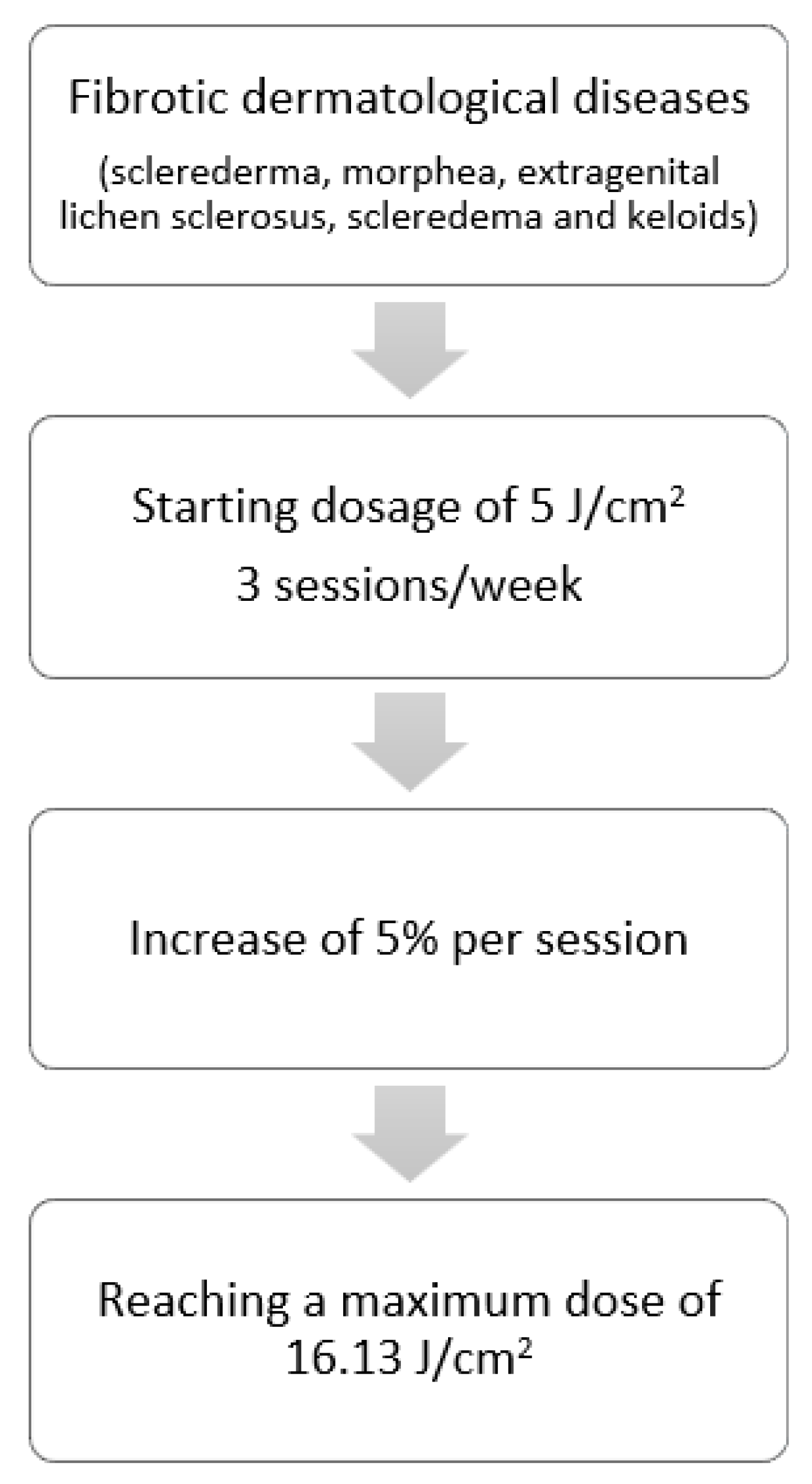
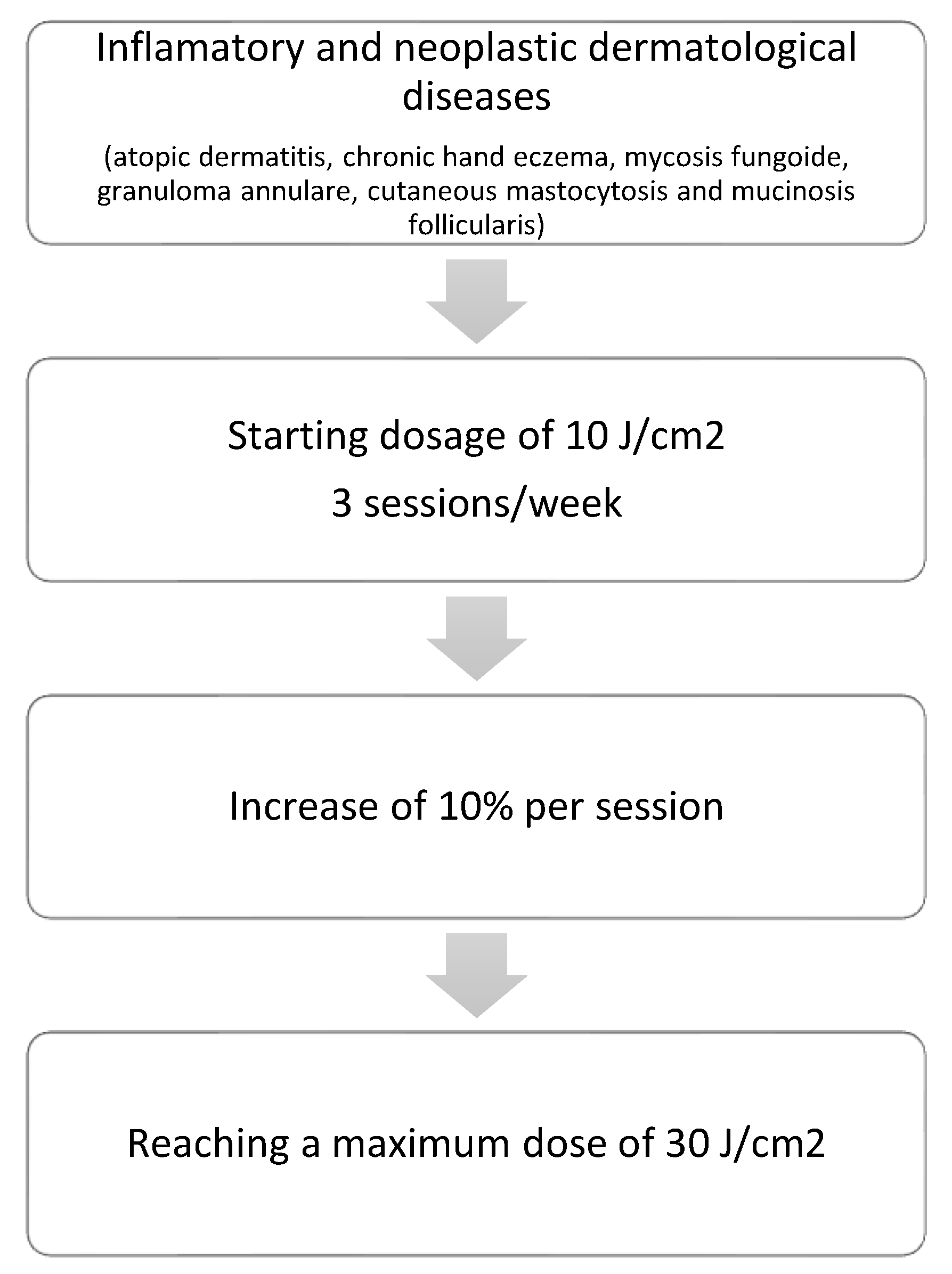
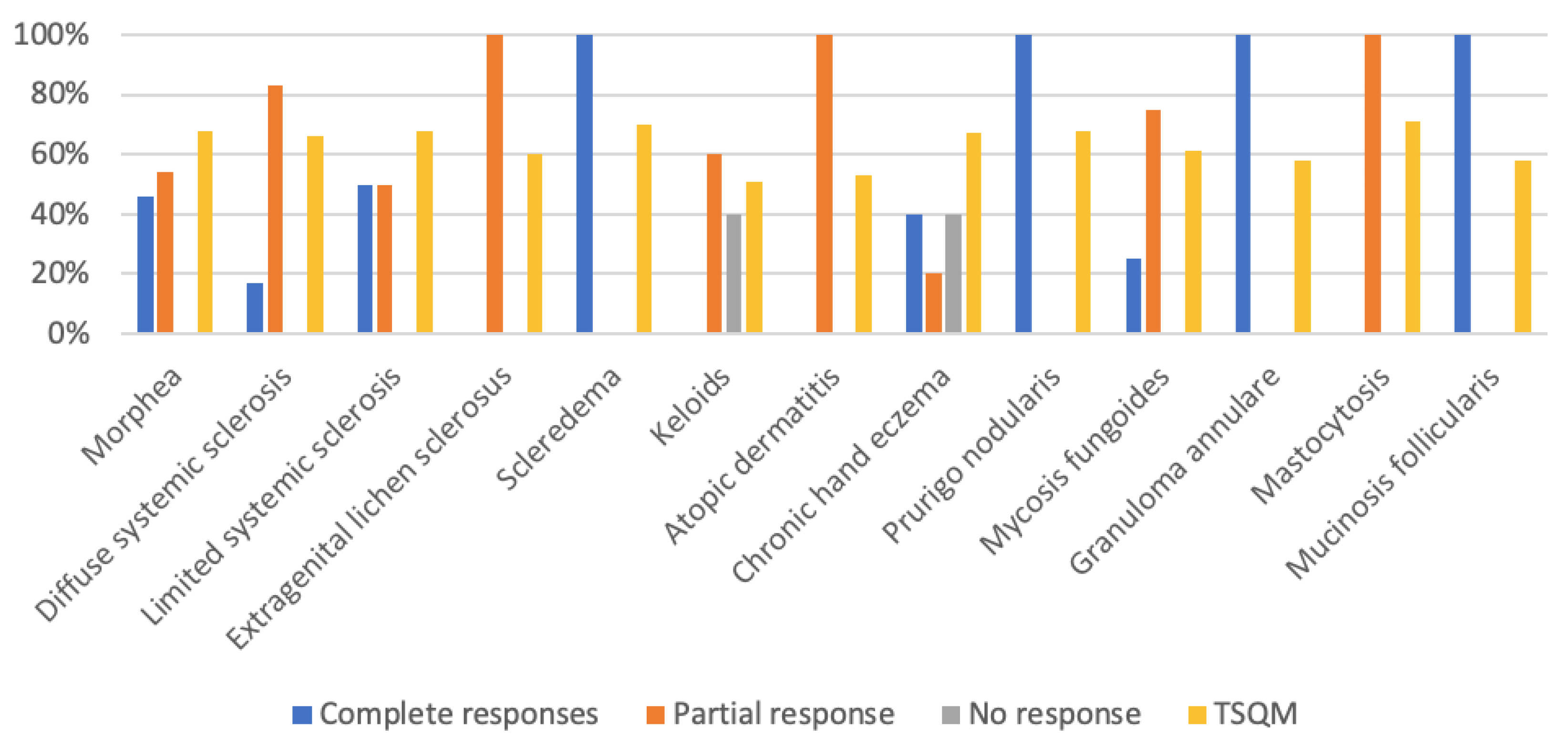
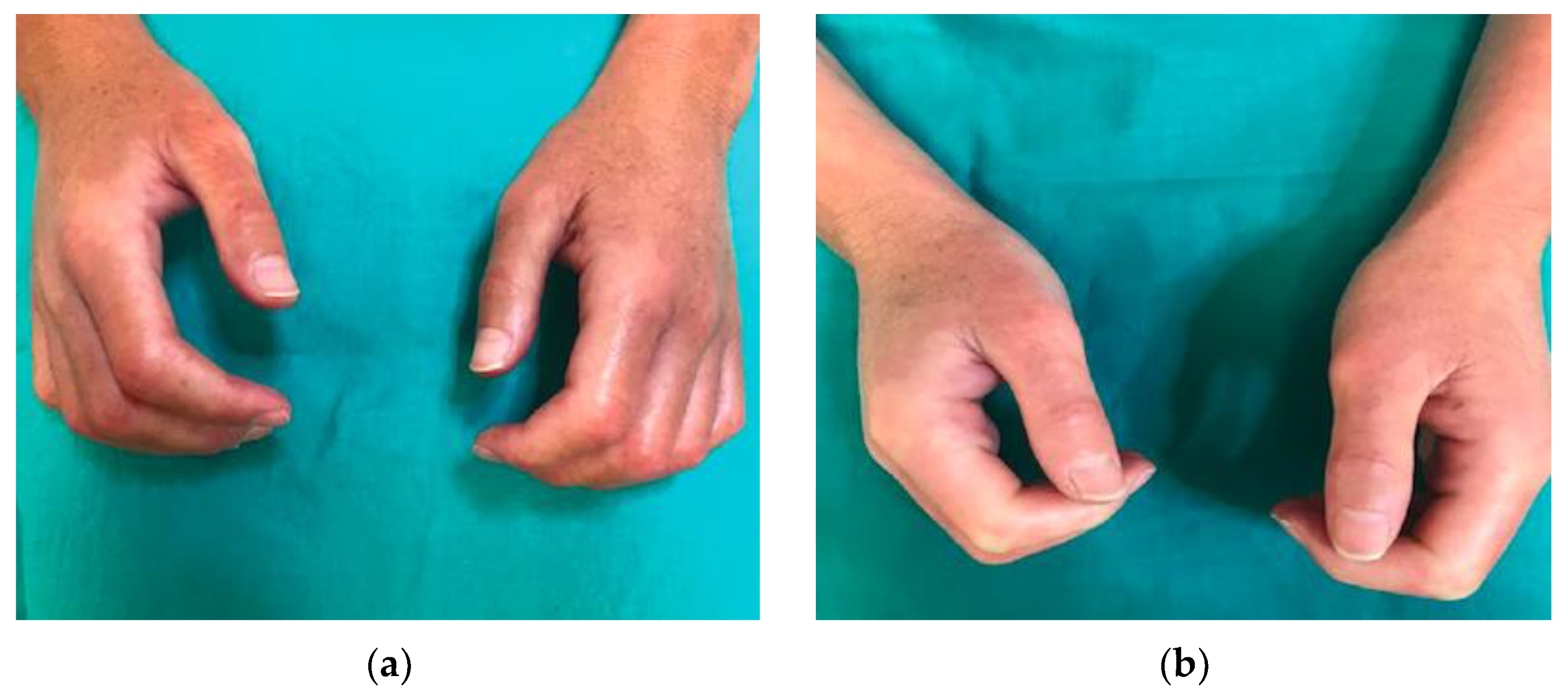
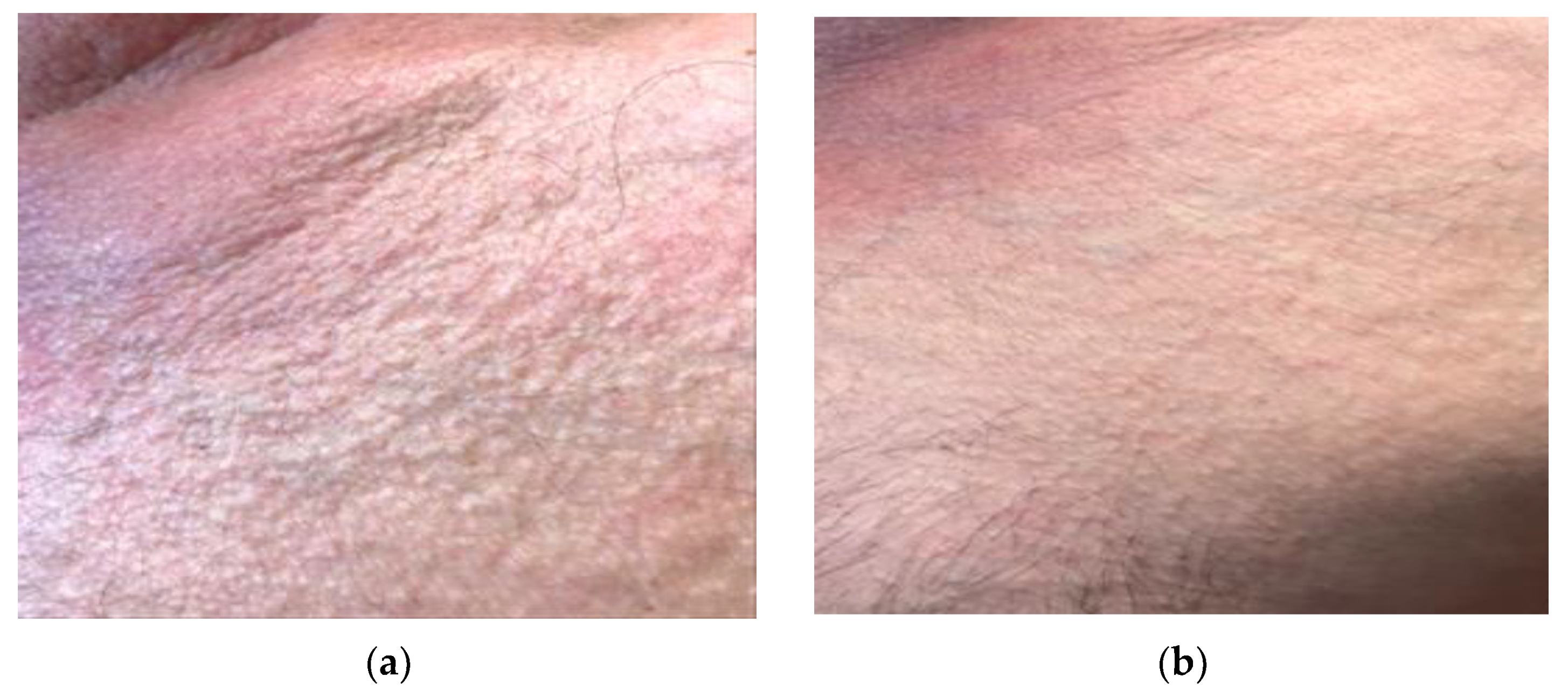
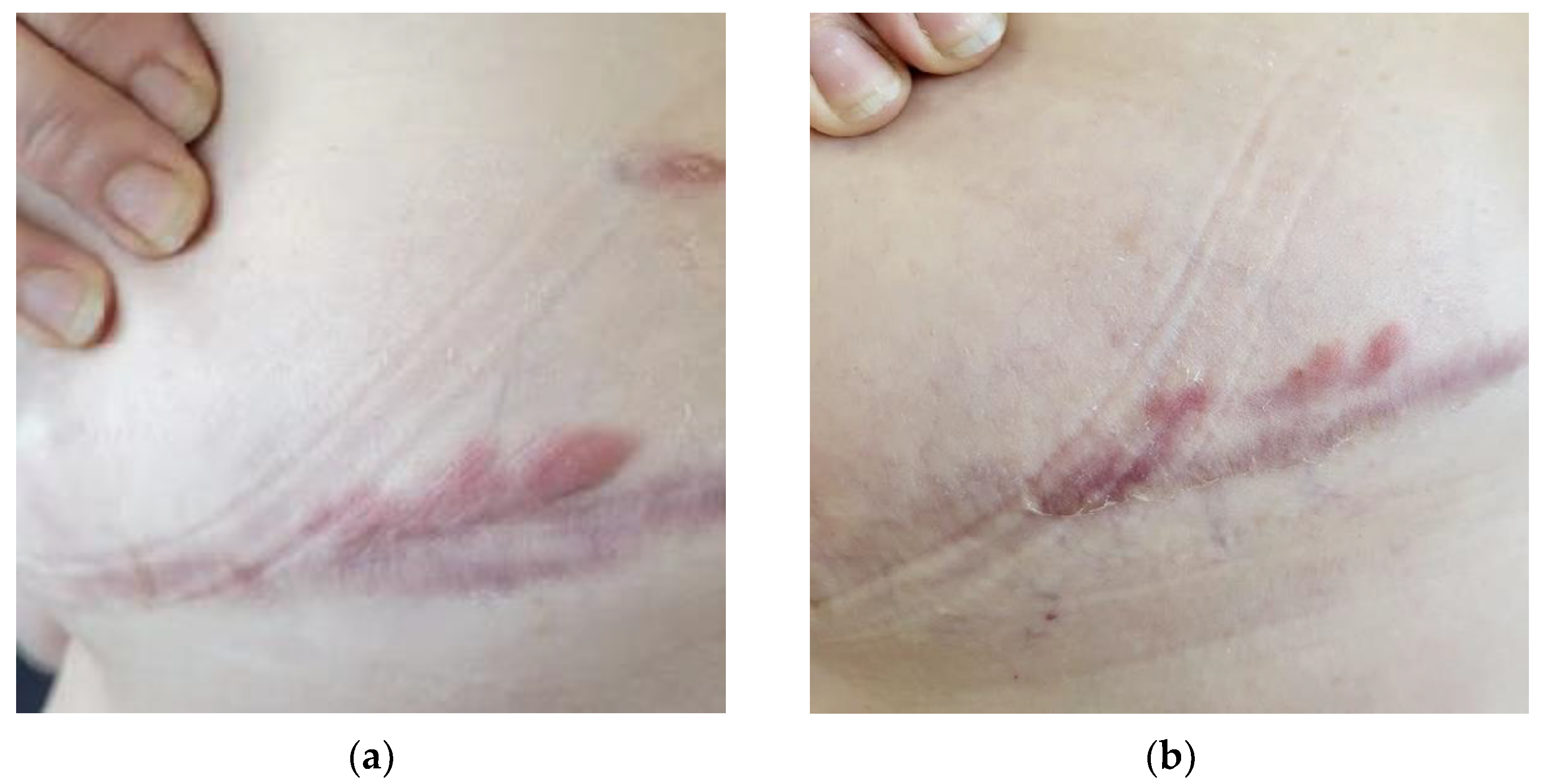
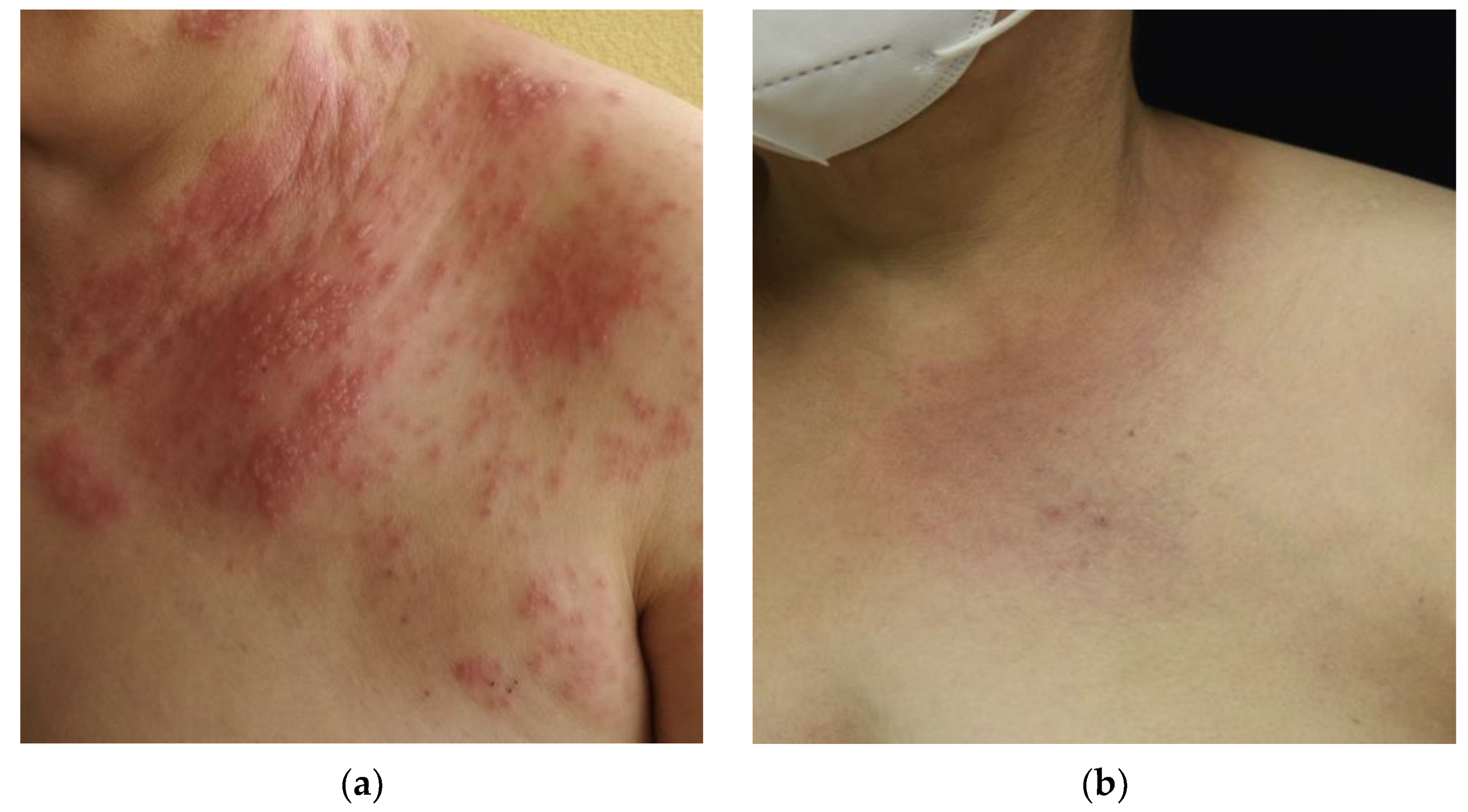
| Diagnosis | Patients | Sex (Male/Female) | Median Age (Range) | Range Sessions per Cycle | Median Total Joules (Range) | Response Complete (>95%) | Response Partial (>50%) | No Response | Median TSQM (Range) | Adverse Effects |
|---|---|---|---|---|---|---|---|---|---|---|
| Morphea | 13 | 2/11 | 56 (18–76) | 17–60 | 321 (111–632) | 6 (46.15%) | 7 (53.85%) | 0 (0%) | 68 (41–72) | Two patients tanning |
| Diffuse systemic sclerosis | 6 | 0/6 | 57 (48–81) | 10–35 | 449 (214–1529) | 1 (16.67%) | 5 (83.33% | 0 (0%) | 65,5 (60–72) | Not referred |
| Limited systemic sclerosis | 2 | 0/2 | 57.5 (42–73) | 20–35 | 377 (323–431) | 1 (50%) | 1 (50%) | 0 (0%) | 68 (66–71) | No referred |
| Extragenital lichen sclerosus | 2 | 0/2 | 69 (62–76) | 30 | 470 (330–610) | 0 (0%) | 2 (100%) | 0 (0%) | 60.5 (56–65) | One patient tanning |
| Scleredema | 2 | 1/1 | 59.5 (55–64) | 25–30 | 619 (108–1130) | 2 (100%) | 0 (0%) | 0 (0%) | 70.5 (69–72) | No referred |
| Keloids | 5 | 2/3 | 36 (25–57) | 10–30 | 331 (47–714) | 0 (0%) | 3 (60%) | 2 (40%) | 51 (41–67) | No referred |
| Atopic dermatitis | 2 | 0/2 | 36.5 (23–50) | 20–25 | 333 (229–437) | 0 (0%) | 2 (100%) | 0 (0%) | 53 (45–61) | One patient skin xerosis |
| Chronic hand eczema | 5 | 2/3 | 54 (23–69) | 30 | 753 (513–805) | 2 (40%) | 1 (20%) | 2 (40%) | 67 (41–72) | No referred |
| Prurigo nodularis | 1 | 0/1 | 67 | 25 | 554 | 1 (100%) | 0 (0%) | 0 (0%) | 68 | No referred |
| Mycosis fungoides | 4 | 3/1 | 49 (24–51) | 30–40 | 853 (567–1679) | 1 (25%) | 3 (75%) | 0 (0%) | 61.5 (48–71) | One patient skin xerosis and transient erythema |
| Granuloma annulare | 2 | 0/2 | 64.5 (57–72) | 20–25 | 158 (118–198) | 2 (100%) | 0 (0%) | 0 (0%) | 58 (51–65) | No referred |
| Mastocytosis | 1 | 0/1 | 40 | 30 | 1686 | 0 (0%) | 1 (100%) | 0 (0%) | 71 | No referred |
| Mucinosis follicularis | 1 | 0/1 | 59 | 30 | 510 | 1 (100%) | 0 (0%) | 0 (0%) | 58 | No referred |
| TOTAL | 46 | 10/36 | 55 (18–81) | 17 (36.96%) | 25 (54.34%) | 4 (8.70%) | 65 (41–72) |
Disclaimer/Publisher’s Note: The statements, opinions and data contained in all publications are solely those of the individual author(s) and contributor(s) and not of MDPI and/or the editor(s). MDPI and/or the editor(s) disclaim responsibility for any injury to people or property resulting from any ideas, methods, instructions or products referred to in the content. |
© 2023 by the authors. Licensee MDPI, Basel, Switzerland. This article is an open access article distributed under the terms and conditions of the Creative Commons Attribution (CC BY) license (https://creativecommons.org/licenses/by/4.0/).
Share and Cite
Velasco-Amador, J.P.; Linares-Gonzalez, L.; De la Torre-Gomar, F.J. Efficacy and Satisfaction of Low Doses UVA1 Phototherapy: A Spanish Experience from a Single Centre. Life 2023, 13, 669. https://doi.org/10.3390/life13030669
Velasco-Amador JP, Linares-Gonzalez L, De la Torre-Gomar FJ. Efficacy and Satisfaction of Low Doses UVA1 Phototherapy: A Spanish Experience from a Single Centre. Life. 2023; 13(3):669. https://doi.org/10.3390/life13030669
Chicago/Turabian StyleVelasco-Amador, Juan Pablo, Laura Linares-Gonzalez, and Francisco Javier De la Torre-Gomar. 2023. "Efficacy and Satisfaction of Low Doses UVA1 Phototherapy: A Spanish Experience from a Single Centre" Life 13, no. 3: 669. https://doi.org/10.3390/life13030669
APA StyleVelasco-Amador, J. P., Linares-Gonzalez, L., & De la Torre-Gomar, F. J. (2023). Efficacy and Satisfaction of Low Doses UVA1 Phototherapy: A Spanish Experience from a Single Centre. Life, 13(3), 669. https://doi.org/10.3390/life13030669





